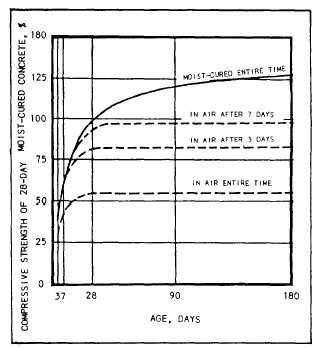rubbing if plywood or lined forms are used. The first rubbing should be done with coarse carborundum stones as soon as the concrete has hardened so that the aggregate is not pulled out. The concrete should then be cured until final rubbing. Finer carborundum stones are used for the final rubbing. The concrete should be kept damp while being rubbed. Any mortar used in this process and left on the surface should be kept damp for 1 to 2 days after it sets to cure properly. The mortar layer should be kept to a minimum thickness as it is likely to scale off and mar the appearance of the surface.
EXPOSED AGGREGATE FINISH
An exposed aggregate finish provides a nonskid surface. To obtain this, you must allow the concrete to harden sufficiently to support the finisher. The aggregate is exposed by applying a retarder over the surface and then brushing and flushing the concrete surface with water. Since timing is important, test panels should be used to determine the correct time to expose the aggregate.
CURING CONCRETE
Adding water to Portland cement to form the water-cement paste that holds concrete together starts a chemical reaction that makes the paste into a bonding agent. This reaction, called hydration, produces a stone-like substance - the hardened cement paste. Both the rate and degree of hydration, and the resulting strength of the final concrete, depend on the curing process that follows placing and consolidating the plastic concrete. Hydration continues indefinitely at a decreasing rate as long as the mixture contains water and the temperature conditions are favorable. Once the water is removed, hydration ceases and cannot be restarted.
Curing is the period of time from consolidation to the point where the concrete reaches its design strength. During this period, you must take certain steps to keep the concrete moist and as near 73F as practical. The properties of concrete, such as freeze and thaw resistance, strength, watertightness, wear resistance, and volume stability, cure or improve with age as long as you maintain the moisture and temperature conditions favorable to continued hydration.
The length of time that you must protect concrete against moisture loss depends on the type of cement used, mix proportions, required strength, size and shape of the concrete mass, weather, and future exposure conditions. The period can vary from a few days to a month or longer. For most structural use, the curing period for cast-in-place concrete is usually 3 days to 2 weeks. This period depends on such conditions as temperature, cement type, mix proportions, and so forth. Bridge decks and other slabs exposed to weather and chemical attack usually require longer curing periods. Figure 7-51 shows how moist curing affects the compressive strength of concrete.
Curing Methods
Several curing methods will keep concrete moist and, in some cases, at a favorable hydration temperature. They fall into two categories: those that

Figure 7-51.-Moist curing effect on compressive strength of concrete.
Continue Reading